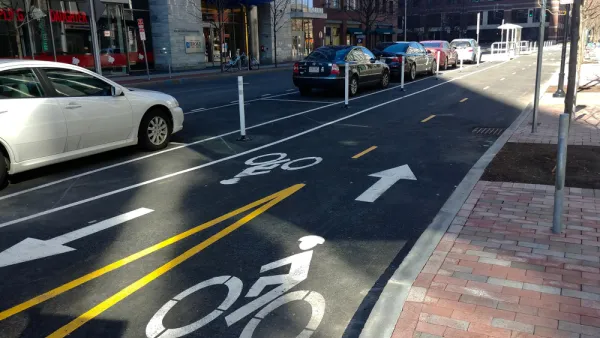The U.S. Department of Transportation wants light-duty vehicles to communicate with each other via advanced technology, known as connected vehicle technology, to prevent crashes. The vehicle-to-vehicle (V2V) rule would be phased in over five years.
"The Transportation Department proposed rules on [Dec. 13] that all new cars and small trucks contain communications technology to broadcast data to one another about their speed, location and direction they are traveling," writes Cecilia Kang, technology regulation reporter for The New York Times. The purpose of the rules are to incorporate advanced technology, known as vehicle-to-vehicle, or V2V, in light vehicles to prevent crashes.
Under the new rules, cars would be able to use wireless technology involving chips and a dedicated band of radio airwaves to detect if another vehicle around the corner and hundreds of yards away was moving too fast in its direction and headed for a collision.
The vehicle-to-vehicle communications technology, which is separate from driverless car tech, is viewed by regulators as the most effective fix for vehicle deaths.
"The Notice of Proposed Rulemaking [link will download a pdf] would enable vehicle-to-vehicle (V2V) communication technology on all new light-duty vehicles, enabling a multitude of new crash-avoidance applications that, once fully deployed, could prevent hundreds of thousands of crashes every year by helping vehicles 'talk' to each other," according to the press release from the National Highway Traffic Safety Association (NHTSA).
According to the executive summary of the notice:
The agency believes that V2V has the potential to revolutionize motor vehicle safety. By providing drivers with timely warnings of impending crash situations, V2V-based safety applications could potentially reduce the number and severity of motor vehicle crashes, thereby reducing the losses and costs to society that would have resulted from these crashes.
NHTSA publicized the release of the notice two years in advance. Former Planetizen editorial intern, Maayan Dembo, cited how specific applications of the technology would save lives:
Two specific applications, Left Turn Assist (LTA) and Intersection Movement Assist (IMA) "could prevent up to 592,000 crashes and save 1,083 lives saved per year. Put another way, V2V technology could help drivers avoid more than half of these types of crashes that would otherwise occur by providing advance warning.
In January 2014, NHTSA indicated it would allow vehicles to use V2V technology. Soon it will be a requirement.
"[NHTSA] proposes phasing in the requirement over five years after issuance of a final regulation," according to AASHTO Journal.
Controversial?
Technology that saves lives, literally, would be expected to be embraced regardless of one's political leanings. Transportation Secretary Anthony Foxx stated, "...from a safety perspective, this is a no-brainer.”
But these are regulations, which by definition are political.
"The conservative Competitive Enterprise Institute immediately called the new mandate a 'midnight' political ploy by the Obama administration and said the incoming administration should abandon the plan," reports Kang. The AAA, on the other hand, was supportive.
AAA, which has supported Foxx’s agenda on car technology and driverless vehicles, said even if new technologies eventually replaced radio communication among cars, the current proposal is a strong solution for safer roads.
"It is unclear how the Trump administration and the incoming transportation secretary, Elaine Chao, will view the technology mandates and guidelines for autonomous vehicles or vehicle-to-vehicle communications," adds Chang.
Vehicle-to-Infrastructure (V2I)
"Separately, the Department’s Federal Highway Administration plans to soon issue guidance for Vehicle-to-Infrastructure (V2I) communications, which will help transportation planners integrate the technologies to allow vehicles to 'talk' to roadway infrastructure such as traffic lights, stop signs and work zones to improve mobility, reduce congestion and improve safety," according to the NHTSA press release.
"Vehicle-to-infrastructure (V2I) technology will take advantage of and build upon emerging vehicle-based technologies being deployed to support vehicle-to-vehicle (V2V) technology," writes Jonathan B. Walker, P.E., Connected Vehicle Program Manger for FHWA in an Intelligent Transportation System (ITS) presentation [PDF] on the technology.
Pilot programs
- Colorado has a head-start on both V2V and V2I applications with a pilot program run by the Colorado Department of Transportation on I-70 based on smart phone application, notes a post in January.
- In September 2015, Secretary Foxx announced that the USDOT Intelligent Transportation Systems (ITS) Joint Program Office would sponsor its first wave of Connected Vehicle Pilots in Midtown Manhattan, Tampa, Fla., and I-80 in southern Wyoming.
Additional NHTSA resources on connected vehicle technology, including fact sheets and videos, are listed at the base of the press release.
Hat tip to Eric Gilbertson.
FULL STORY: Cars Talking to One Another? They Could Under Proposed Safety Rules

Analysis: Cybertruck Fatality Rate Far Exceeds That of Ford Pinto
The Tesla Cybertruck was recalled seven times last year.

National Parks Layoffs Will Cause Communities to Lose Billions
Thousands of essential park workers were laid off this week, just before the busy spring break season.

Retro-silient?: America’s First “Eco-burb,” The Woodlands Turns 50
A master-planned community north of Houston offers lessons on green infrastructure and resilient design, but falls short of its founder’s lofty affordability and walkability goals.

Test News Post 1
This is a summary

Analysis: Cybertruck Fatality Rate Far Exceeds That of Ford Pinto
The Tesla Cybertruck was recalled seven times last year.

Test News Headline 46
Test for the image on the front page.
Urban Design for Planners 1: Software Tools
This six-course series explores essential urban design concepts using open source software and equips planners with the tools they need to participate fully in the urban design process.
Planning for Universal Design
Learn the tools for implementing Universal Design in planning regulations.
EMC Planning Group, Inc.
Planetizen
Planetizen
Mpact (formerly Rail~Volution)
Great Falls Development Authority, Inc.
HUDs Office of Policy Development and Research
NYU Wagner Graduate School of Public Service



























